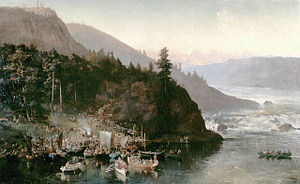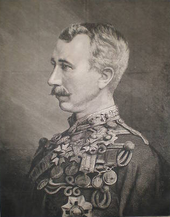Wolseley expedition
This article includes a list of general references, but it lacks sufficient corresponding inline citations. (February 2013) |
| Wolseley expedition | |||||||
|---|---|---|---|---|---|---|---|
| Part of Red River Rebellion | |||||||
 Red River Expedition at Kakabeka Falls by Frances Anne Hopkins, 1877 | |||||||
| |||||||
| Belligerents | |||||||
|
|
| ||||||
| Commanders and leaders | |||||||
| Garnet Wolseley | Louis Riel | ||||||
| Casualties and losses | |||||||
| None | None | ||||||
The Wolseley expedition was a military force authorized by Sir John A. Macdonald to confront Louis Riel and the Métis in 1870, during the Red River Rebellion, at the Red River Colony in what is now the Canadian province of Manitoba. The expedition was also intended to counter American expansionist sentiments in northern border states. After a journey of months in arduous conditions, the Expedition arrived at, and captured, Fort Garry, extinguished Riel's Provisional Government and eradicated the threat of the U.S. being able to easily wrest western Canada from Confederation.
History

Under the leadership of Colonel Garnet Wolseley, the expedition set out in May 1870 from Toronto, Ontario, in an attempt to interdict Riel. The U.S. government had refused permission for the troops to cross U.S. soil, and many thought it impossible to move a military force into western Canada via an all-Canadian route, the Dawson Road having been mapped out only three years earlier and the railway still many years away. But the difficulties were overcome, and the force arrived at Winnipeg in August.[1]

The expedition travelled to Georgian Bay, then by steamer across Lake Huron to the U.S. Sault Canal where men and materiel had to be transported on the Canadian side of the river, across Lake Superior to the Department of Public Works station at Thunder Bay which Wolseley named Prince Arthur's Landing on May 25, 1870, in honour of Queen Victoria's third son. From there the troops carried small boats to Lake Shebandowan. Travelling further westwards, they passed through Fort Frances to Lake of the Woods. They proceeded down the Winnipeg River and across the south basin of Lake Winnipeg to the Red River finally arriving at Fort Garry in late August.
Wolseley formed up his troops and immediately began his advance on Upper Fort Garry. Riel and his followers abandoned the fort with the result it was taken in a "bloodless" action.
An eyewitness account of the expedition's arrival at Upper Fort Garry, provided by a member of the expedition, William Perrin, appeared in the Manitoba Free Press in August 1900 on the 30th anniversary of the arrival. Perrin was a regular British soldier of the 60th (The King's Royal Rifle Corps) Regiment of Foot.
The expedition is considered by military historians to have been among the most arduous in history. Over 1,000 men had to transport all their provisions and weaponry including cannon over hundreds of miles of wilderness. At numerous portages, corduroy roads had to be constructed. As these jobs were being done, the troops had to endure life in the bush for over two months, in summer heat and the inevitable plagues of blackflies and mosquitoes.
Following the successful completion of the expedition, Wolseley penned a tribute to his men in recognition of their extraordinary efforts.
Imperial military forces in the Red River Rebellion
- 60th Regiment
- 1st Ontario Rifles
- 1st Quebec Rifles
- Detachment of Royal Artillery
- Detachment of Royal Engineers
- Detachment of Army Service Corps
- Detachment of Army Hospital Corps[2]
The North-West Mounted Police, established three years later in 1873, did not take part in the expedition.
References
- ^ Dawson, Simon James (1871). Report on the Red River expedition of 1870: Printed by the order of the House of Commons: Reprint, with remarks on certain strictures published in England by an officer of the expeditionary force. Ottawa: Printed by the Times Printing & Publishing Co.
- ^ Rowboat Diplomacy: The Dominion of Canada’s Whole of Government Approach to The Red River Rebellion by David W. Grebstad, Canadian Military Journal Volume 13, Number 3 Accessed 14 August 2014
- Canadian Campaigns, 1860-1870 (pub Osprey 1992, ISBN 1-85532-226-9)
- Sir Garnet Wolseley: Victorian Hero (by Halik Kochanski, pub 2001, ISBN 1-85285-188-0)
- The British Army on Campaign, 1856-81 (pub Osprey 1988, ISBN 0-85045-835-8)
- Toil & Trouble: Military Expeditions to Red River (by George F.G. Stanley, pub 1989, ISBN 1-55002-059-5)
